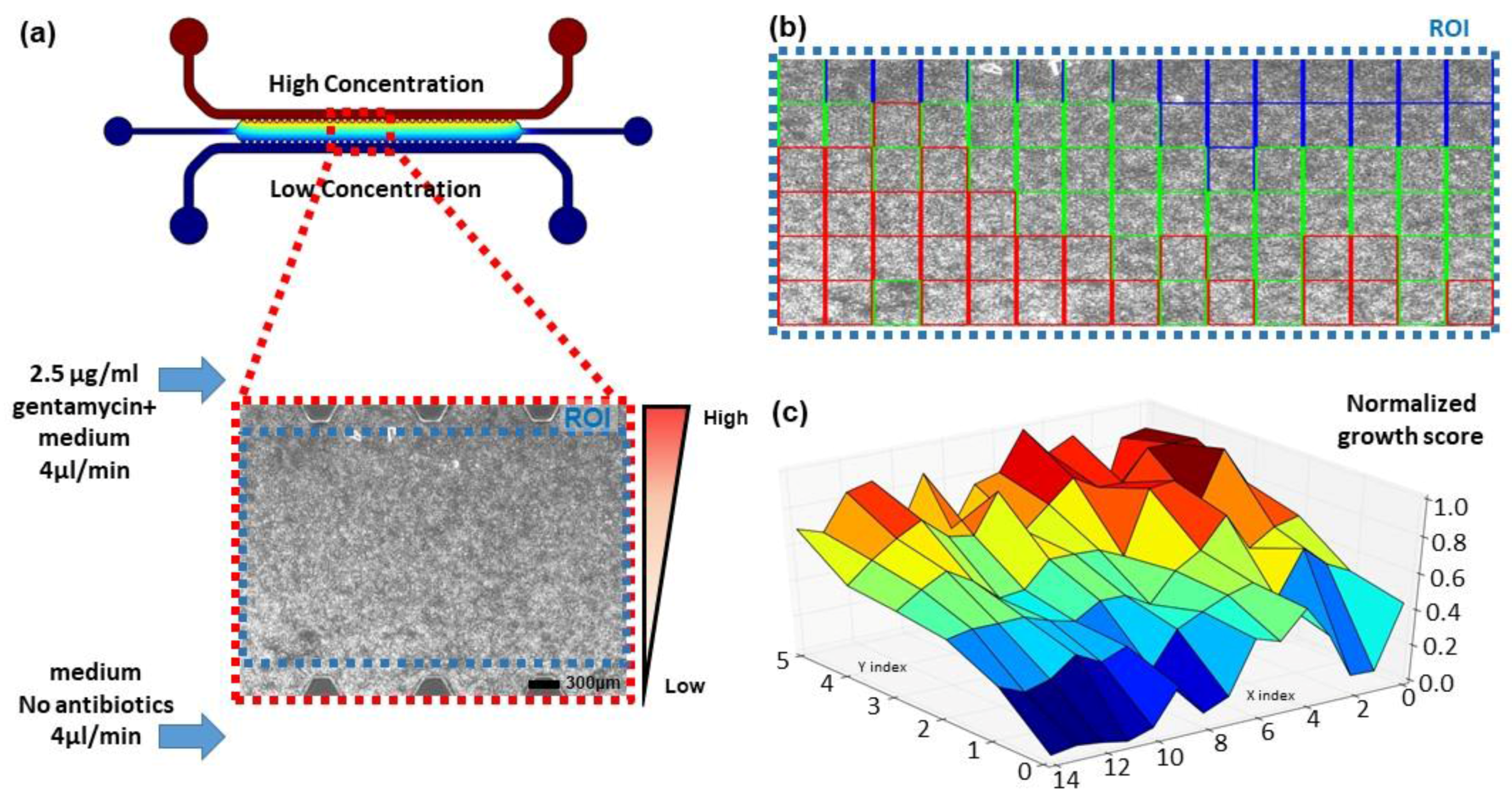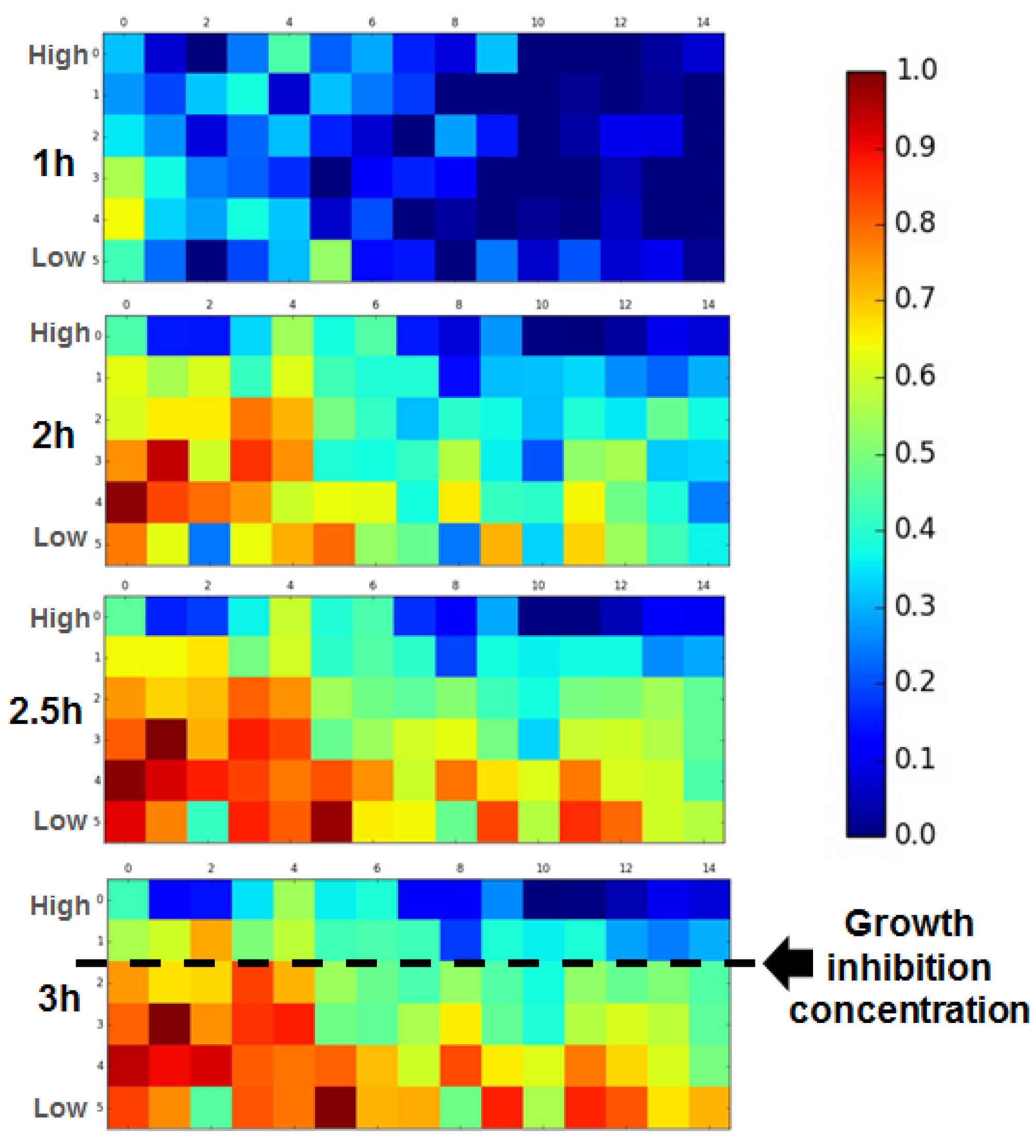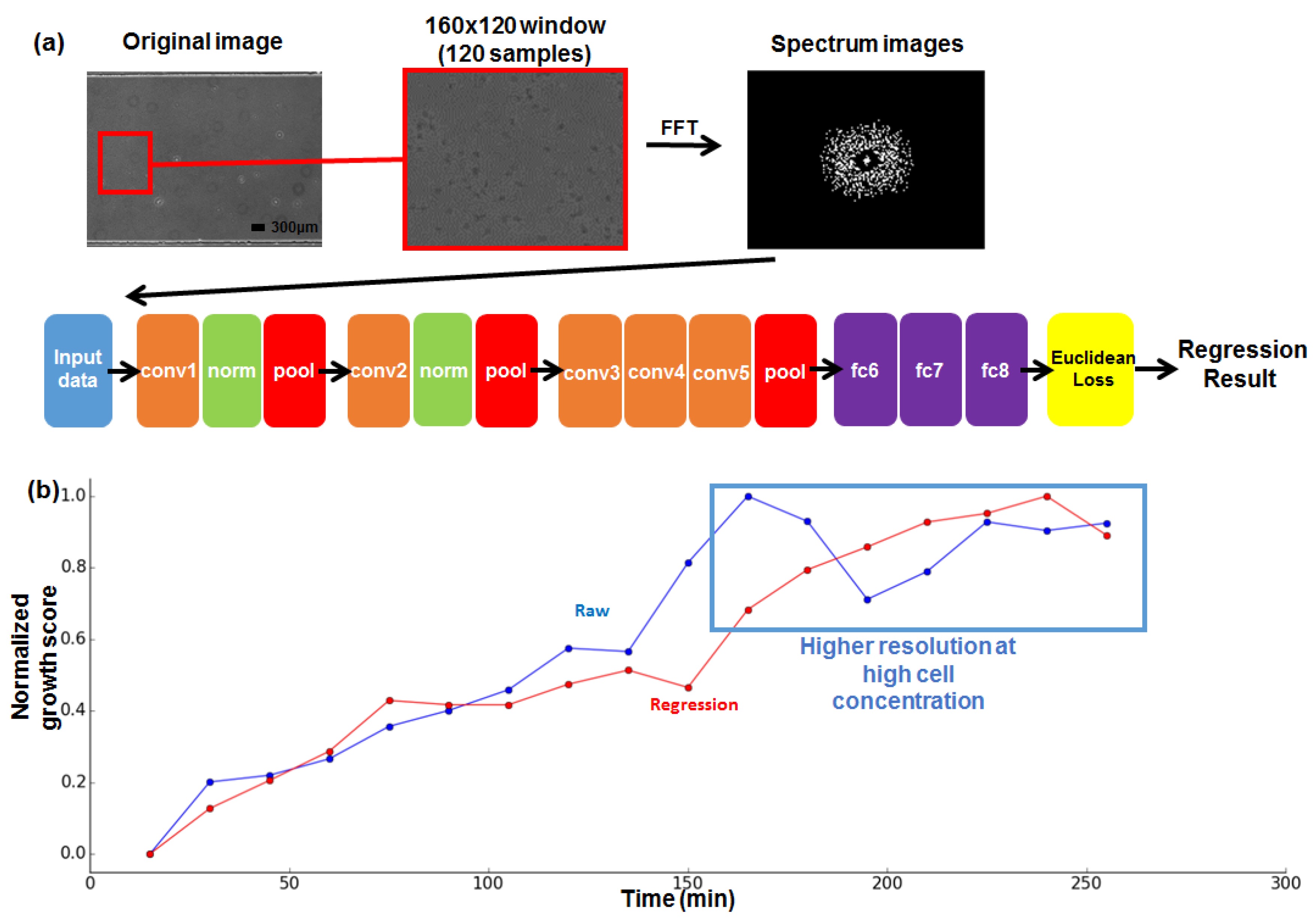Visual Estimation of Bacterial Growth Level in Microfluidic Culture Systems
Abstract
:1. Introduction
2. Materials and Methods
2.1. Microfluidic Device Preparation
2.2. On-Chip Bacterial Culture and Image Acquisition
2.3. Image Acquisition and Processing for Growth Estimation
2.4. CFU Measurement
2.5. Culture under Antibiotics Gradient
2.6. Deep Nerual Network Setups
3. Results and Discussion
3.1. Growth Level Estimation with the FFT
3.2. Comparison with Conventional Growth Estimation Methods
3.3. Application of the Proposed Technique for the AST Experiment
3.4. Deep Neural Network Assisted Growth Level Regression
4. Conclusions and Future Work
Supplementary Materials
Acknowledgments
Author Contributions
Conflicts of Interest
References
- Park, S.; Hong, X.; Choi, W.; Kim, T. Microfabricated ratchet structure integrated concentrator arrays for synthetic bacterial cell-to-cell communication assays. Lab Chip 2012, 12, 3914–3922. [Google Scholar] [CrossRef] [PubMed] [Green Version]
- Kim, S.; Cestellos-Blanco, S.; Inoue, K.; Zare, R. Miniaturized Antimicrobial Susceptibility Test by Combining Concentration Gradient Generation and Rapid Cell Culturing. Antibiotics 2015, 4, 455–466. [Google Scholar] [CrossRef] [PubMed]
- Kim, K.; Myung, H. Sensor Node for Remote Monitoring of Waterborne Disease-Causing Bacteria. Sensors 2015, 15, 10569–10579. [Google Scholar] [CrossRef] [PubMed]
- Grünberger, A.; van Ooyen, J.; Paczia, N.; Rohe, P.; Schiendzielorz, G.; Eggeling, L.; Wiechert, W.; Kohlheyer, D.; Noack, S. Beyond growth rate 0.6: Corynebacterium glutamicumcultivated in highly diluted environments. Biotechnol. Bioeng. 2012, 110, 220–228. [Google Scholar] [PubMed]
- Luli, G.; Strohl, W. Comparison of growth, acetate production, and acetate inhibition of Escherichia coli strains in batch and fed-batch fermentations. Appl. Environ. Microbiol. 1990, 56, 1004–1011. [Google Scholar] [PubMed]
- Wang, P.; Robert, L.; Pelletier, J.; Dang, W.; Taddei, F.; Wright, A.; Jun, S. Robust Growth of Escherichia coli. Curr. Biol. 2010, 20, 1099–1103. [Google Scholar] [CrossRef] [PubMed]
- Kim, K.; Kim, Y.; Choi, C.; Kim, H.; Lee, S.; Chang, W.; Lee, C. In situ monitoring of antibiotic susceptibility of bacterial biofilms in a microfluidic device. Lab Chip 2010, 10, 3296–3299. [Google Scholar] [CrossRef] [PubMed]
- Funes-Huacca, M.; Wu, A.; Szepesvari, E.; Rajendran, P.; Kwan-Wong, N.; Razgulin, A.; Shen, Y.; Kagira, J.; Campbell, R.; Derda, R. Portable self-contained cultures for phage and bacteria made of paper and tape. Lab Chip 2012, 12, 4269–4278. [Google Scholar] [CrossRef] [PubMed]
- Lu, H.; Caen, O.; Vrignon, J.; Zonta, E.; Harrak, Z.E.; Nizard, P.; Baret, J.C.; Taly, V. High throughput single cell counting in droplet-based microfluidics. Sci. Rep. 2017, 7, 1366. [Google Scholar] [CrossRef] [PubMed]
- Kim, K.; Choi, D.; Lim, H.; Kim, H.; Jeon, J. Vision Marker-Based In Situ Examination of Bacterial Growth in Liquid Culture Media. Sensors 2016, 16, 2179. [Google Scholar] [CrossRef] [PubMed]
- Kim, K.; Hyun, J.; Jeon, J. Light Emitting Marker for Robust Vision-Based On-The-Spot Bacterial Growth Detection. Sensors 2017, 17, 1459. [Google Scholar] [CrossRef] [PubMed]
- Toyoura, M.; Aruga, H.; Turk, M. Detecting Markers in Blurred and Defocused Images. In Proceedings of the 2013 International Conference on Cyberworlds (CW 2013), Yokohama, Japan, 21–23 October 2013; pp. 183–190. [Google Scholar]
- Shin, Y.; Han, S.; Jeon, J.; Yamamoto, K.; Zervantonakis, I.; Sudo, R.; Kamm, R.; Chung, S. Microfluidic assay for simultaneous culture of multiple cell types on surfaces or within hydrogels. Nat. Protoc. 2012, 7, 1247–1259. [Google Scholar] [CrossRef] [PubMed]
- Wijnen, B.; Hunt, E.; Anzalone, G.; Pearce, J. Open-Source Syringe Pump Library. PLoS ONE 2014, 9, e107216. [Google Scholar] [CrossRef] [PubMed]
- Farahat, W.A.; Wood, L.B.; Zervantonakis, I.K.; Schor, A.; Ong, S.; Neal, D.; Kamm, R.D.; Asada, H.H. Ensemble analysis of angiogenic growth in three-dimensional microfluidic cell cultures. PLoS ONE 2012, 7, e37333. [Google Scholar] [CrossRef] [PubMed] [Green Version]
- Das, A.; Lenz, S.M.; Awojoodu, A.O.; Botchwey, E.A. Abluminal Stimulation of Sphingosine 1-Phosphate Receptors 1 and 3 Promotes and Stabilizes Endothelial Sprout Formation. Tissue Eng. 2015, 21, 202–213. [Google Scholar] [CrossRef] [PubMed]
- De Boer, P.; Kroese, D.; Mannor, S.; Rubinstein, R. A Tutorial on the Cross-Entropy Method. Ann. Oper. Res. 2005, 134, 19–67. [Google Scholar] [CrossRef]
- Jia, Y.; Shelhamer, E.; Donahue, J.; Karayev, S.; Long, J.; Girshick, R.; Guadarrama, S.; Darrell, T. Caffe: Convolutional Architecture for Fast Feature Embedding. Available online: https://arxiv.org/abs/1408.5093 (accessed on 23 December 2017).
- Shekarabi, M.; Hajikhani, B.; Salimi Chirani, A.; Fazeli, M.; Goudarzi, M. Molecular characterization of vancomycin-resistant Staphylococcus aureus strains isolated from clinical samples: A three year study in Tehran, Iran. PLoS ONE 2017, 12, e0183607. [Google Scholar] [CrossRef] [PubMed]
- Simonyan, K.; Zisserman, A. Very Deep Convolutional Networks for Large-Scale Image Recognition. Available online: https://arxiv.org/abs/1409.1556 (accessed on 23 December 2017).
- Szegedy, C.; Liu, W.; Jia, Y.; Sermanet, P.; Reed, S.; Anguelov, D.; Erhan, D.; Vanhoucke, V.; Rabinovich, A. Going Deeper with Convolutions. Available online: https://arxiv.org/abs/1409.4842 (accessed on 23 December 2017).
- Krizhevsky, A.; Sutskever, I.; Hinton, G. ImageNet classification with deep convolutional neural networks. Commun. ACM 2017, 60, 84–90. [Google Scholar] [CrossRef]
- Long, J.; Shelhamer, E.; Darrell, T. Fully Convolutional Networks for Semantic Segmentation. Available online: https://arxiv.org/abs/1411.4038 (accessed on 23 December 2017).
- Redmon, J.; Divvala, S.; Girshick, R.; Farhadi, A. You Only Look Once: Unified, Real-Time Object Detection. Available online: https://arxiv.org/abs/1506.02640 (accessed on 23 December 2017).
- Santoro, A.; Bartunov, S.; Botvinick, M.; Wierstra, D.; Lillicrap, T. One-shot Learning with Memory-Augmented Neural Networks. Available online: https://arxiv.org/abs/1605.06065 (accessed on 23 December 2017).
- Reis, N.; Pivetal, J.; Loo-Zazueta, A.; Barros, J.; Edwards, A. Lab on a stick: Multi-analyte cellular assays in a microfluidic dipstick. Lab Chip 2016, 16, 2891–2899. [Google Scholar] [CrossRef] [PubMed]
- Gan, M.; Su, J.; Wang, J.; Wu, H.; Chen, L. A scalable microfluidic chip for bacterial suspension culture. Lab Chip 2011, 11, 4087–4092. [Google Scholar] [CrossRef] [PubMed]





| Layer Name | Size | Specification |
|---|---|---|
| conv1 | 96, 11 | Filter, kernel |
| pool1 | 3, 2 | Kernel, stride |
| conv2 | 256, 5 | |
| pool2 | 3, 2 | |
| conv3 | 384, 3 | |
| conv4 | 384, 3 | |
| conv5 | 256, 3 | |
| pool5 | 3, 2 | |
| fc6 | 4096 | Innerproduct |
| fc7 | 4096 | |
| fc8 | 1000 |
| Source | CFU (Unit/100 μL) | Normalized FFT Score |
|---|---|---|
| Liquid 0 h | 2 × 105 | 0.115 ± 0.063 |
| Liquid 4 h | 70 × 106 | 0.875 ± 0.087 |
| Agar 0 h | 2 × 105 | 0.079 ± 0.015 |
| Agar 4 h | 12 × 106 | 0.80 ± 0.077 |
© 2018 by the authors. Licensee MDPI, Basel, Switzerland. This article is an open access article distributed under the terms and conditions of the Creative Commons Attribution (CC BY) license (http://creativecommons.org/licenses/by/4.0/).
Share and Cite
Kim, K.; Kim, S.; Jeon, J.S. Visual Estimation of Bacterial Growth Level in Microfluidic Culture Systems. Sensors 2018, 18, 447. https://doi.org/10.3390/s18020447
Kim K, Kim S, Jeon JS. Visual Estimation of Bacterial Growth Level in Microfluidic Culture Systems. Sensors. 2018; 18(2):447. https://doi.org/10.3390/s18020447
Chicago/Turabian StyleKim, Kyukwang, Seunggyu Kim, and Jessie S. Jeon. 2018. "Visual Estimation of Bacterial Growth Level in Microfluidic Culture Systems" Sensors 18, no. 2: 447. https://doi.org/10.3390/s18020447





